MaelStrom Live Transcoding Deep Dive
Last updated: 19 April 2023

Let’s talk about the exciting world of creating multiple video qualities.
The unreliable web
The internet is a global, unreliable patchwork of thousands of interconnected networks. In contrast to cable TV or IPTV, there is no end-to-end Quality of Service. If you want to send high-quality streams across the world, there is a risk of buffering due to internet bandwidth restrictions and fluctuations.
Adaptive bit rate live streaming
Nobody likes waiting and buffering. That is why adaptive bit rate live streaming was invented. You probably have experienced that the quality of videos or live streams can go up and down.
Player logic
Video players have algorithms to ensure that the most optimal quality of a stream is displayed, depending on your screen size, device capabilities and actual bandwidth. That’s pretty smart. But for a video player to select the right quality, these multiple qualities of the same stream must first be created. That’s where transcoding comes in: the process of creating multiple qualities of a source stream.
On-premises live transcoding
Encoders are responsible for creating a source stream out of an audiovisual feed. Transcoders are responsible for creating multiple qualities. Some live encoders can create multiple quality streams. However, there are some drawbacks to on-premises transcoding, especially on live event locations:
- Equipment. Encoding is a very resource-intense process. You need heavy and expensive hardware, especially when transcoding to multiple qualities in real-time.
- Uplinks. Upstream connections are critical. If they fail, the audience will experience dropouts. You need a very high-capacity uplink to upstream multiple quality streams, which is expensive and sometimes simply unavailable.
- Syncing. It’s quite hard for on-premises encoders to keep multiple qualities of the same stream synchronized. Viewers don’t appreciate syncing issues when video players step up or down the bit rate ladder.
- Energy consumption. Encoding and transcoding require a lot of power. Chances are that the energy supply on location isn’t based on renewable resources.
(For the record, Jet-Stream Cloud fully supports multi bit rate on-premises and 3rd party transcoding for live and vod with numerous workflow options such as protocol transmuxing to HLS/DASH, and direct HLS/DASH ingest and caching.)
Cloud based live transcoding.
Live transcoding in the cloud offers some advantages:
- Scale. Cloud computing offers dynamic scalability, with on-the-fly use. There’s no need for heavy and expensive encoding equipment on location.
- Connectivity. Send one high quality origin feed to the cloud via your upstream connection. This results in a more reliable stream, and the cloud has plenty capacity to scale up and feed the adaptive streams to CDNs.
- Syncing. Creating the bit rates in the origin in the cloud guarantees better syncing between the bit rates compared to on-premises transcoding.
But there are some downsides to generic cloud based live transcoding too:
- Complexity. Managing transcoding services in the cloud requires both cloud and transcoding expertise, which is expensive, and hard to find and keep.
- Costs. Generic clouds seem affordable but become notoriously expensive as soon as you scale up, and you can be surprised with all the unexpected costs for microservices. Especially 24*7 video transcoding, which is a very heavy process, can easily cost you thousands, even ten-thousands per month.
- Energy. Cloud data centers can consume as much power as a city. Transcoding in the cloud is very CPU and energy intensive. The ecological footprint of clouds is a challenge.
- Data protection. Most clouds can’t guarantee GDPR compliancy. Who else can access your media and your data? Are they safe?
- Latency. Cloud based transcoding adds unwanted latency to streams. In more and more use cases low latency is a necessity.
(If you need, you can use any cloud based transcoding service and connect it to Jet-Stream Cloud via the HTTP stream pull or remote origin features.)
Video platform transcoding
Video platforms offer integrated transcoding. Their main benefit over cloud-based transcoding is that they are somewhat easier: Connect your encoder, the platform then transcodes magically.
But video platform transcoding has some major drawbacks too:
- Video platforms run on the same generic clouds, so all the drawbacks such as latency, data protection, footprint and costs are still there, even more expensive.
- By automating transcoding, they filter away all your control over quality and costs.
- Resilience can’t always be guaranteed because of a lack of redundancy, or because of dependency on third-party clouds.
- Are video platforms really easy? You still have to have expertise in live encoding and have to operate, configure, and connect encoders.
- Finally, you are locked in one service that you can’t easily integrate with other platforms such as Jet-Stream Cloud.
Jet-Stream’s MaelStrom Live
MaelStrom Live is Jet-Stream’s new live transcoding service. It is designed to bring you all the benefits of cloud-based transcoding and video platform transcoding over on-premises transcoding, but without the associated drawbacks:
- Scale. Jet-Stream Cloud is a purpose built-cloud with hardware acceleration for live transcoding, offering scale advantages over on-premises transcoding and performance advantages over regular, virtualized, CPU-based cloud services.
- Connectivity. Jet-Stream Cloud runs on a pan-European fiber network that lets you contribute your origin streams in a reliable way. With direct links to major CDNs, your transcoded streams are reliably fed into global delivery networks.
- Syncing. Jet-Stream Cloud actively syncs all bit rates and the audio for a great quality of experience.
- Easy. The easiest live transcoding service on the market. Encode and transcode even without the need for on-premises encoders. Click and stream. Connect professional hardware and software encoders in a click. Create custom transcoding profiles in real-time, in a click too.
- Full quality and cost control. You decide per stream in which qualities you encode. You have full control over bit rates, costs, and on storage and traffic costs. Thanks to hardware acceleration, MaelStrom Live is up to 75% cheaper compared to competitors on generic clouds. Scene optimization further reduces bandwidth costs, while maintaining picture quality.
- Energy. Jet-Stream Cloud is green. It runs on renewable energy, and transcoding is hardware accelerated, saving an impressive 89% in energy consumption.
- Data protection. Jet-Stream Cloud is 100% European and GDPR audited. No foreign, U.S.-owned or operated services are used. Make sure you don’t pay with your data.
- Latency. MaelStrom live can offer sub frame latency live transcoding, compared to seconds when using a generic video platform or cloud based services.
- Resilient. Redundant transcoding, isolated containers, automatic recovery and 24/7 webcast hotline support can deliver up to 99.999% uptime for your mission critical live streams.
- Open. Jet-Stream Cloud’s open Mix architecture lets you live transcode in easy, smart and expert ways, giving you full control over how you want to implement a workflow and 3rd party systems to build workflows that follow your use case, instead of platforms that let their workflow dominate your use case and business case.
Easy.
Let’s start with the easiest way of doing live transcoding in our industry:
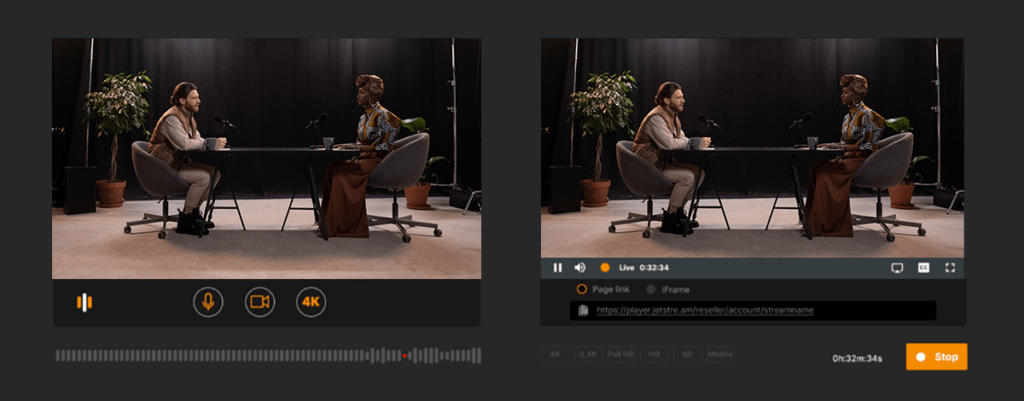
With Jet-Stream Cloud, you don’t even need an on-premises encoder anymore. Just connect your studio or camera source to your laptop, open OnAir straight from your browser, and… go OnAir. That’s it, the live transcoding process starts automatically, and it will end when you finish your live stream.
When you want to use your own hardware or software encoder, there is another easy way to use the MaelStrom transcoding service, through the ‘Live Streams’ menu. Just go there and select RTMP/RTSP for example. Provide a name for your stream and click to create the live stream. The system automatically starts live transcoding your video into the qualities within the default transcoding profile. It’s that simple!
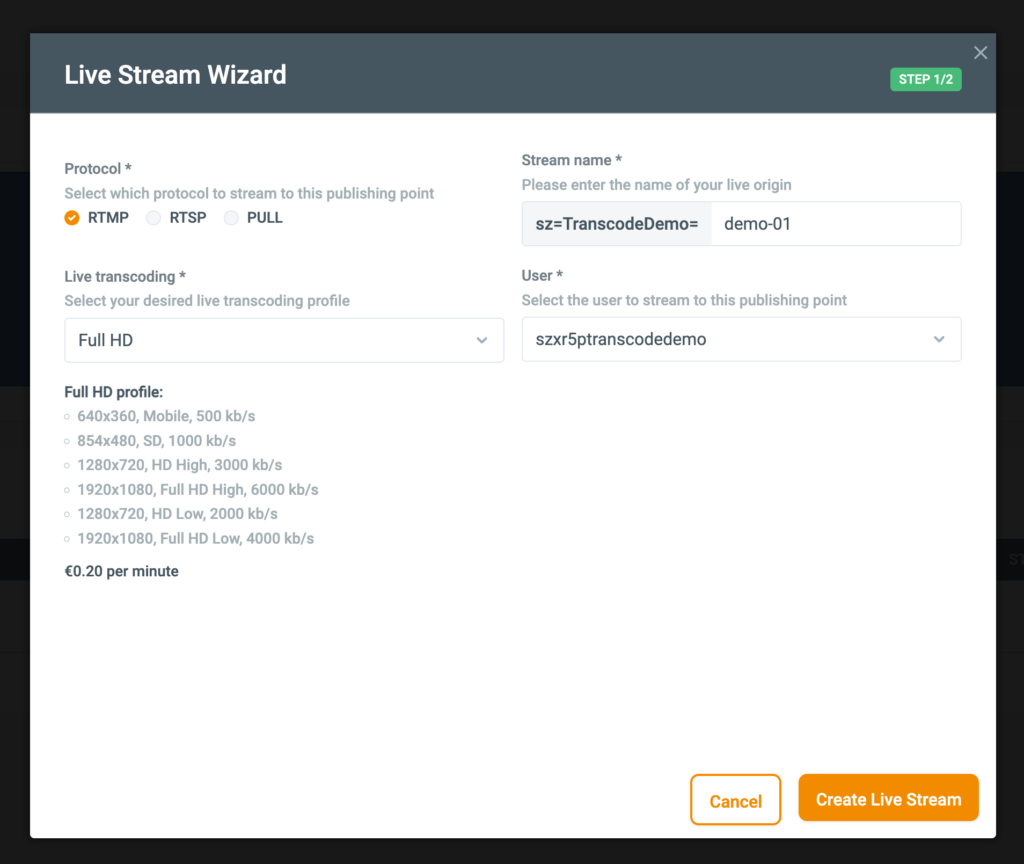
You can view your active streams in the ‘Configured Jobs’ list in the Live Transcoding menu. Old live stream transcoding jobs are shown under the ‘Completed Jobs’.
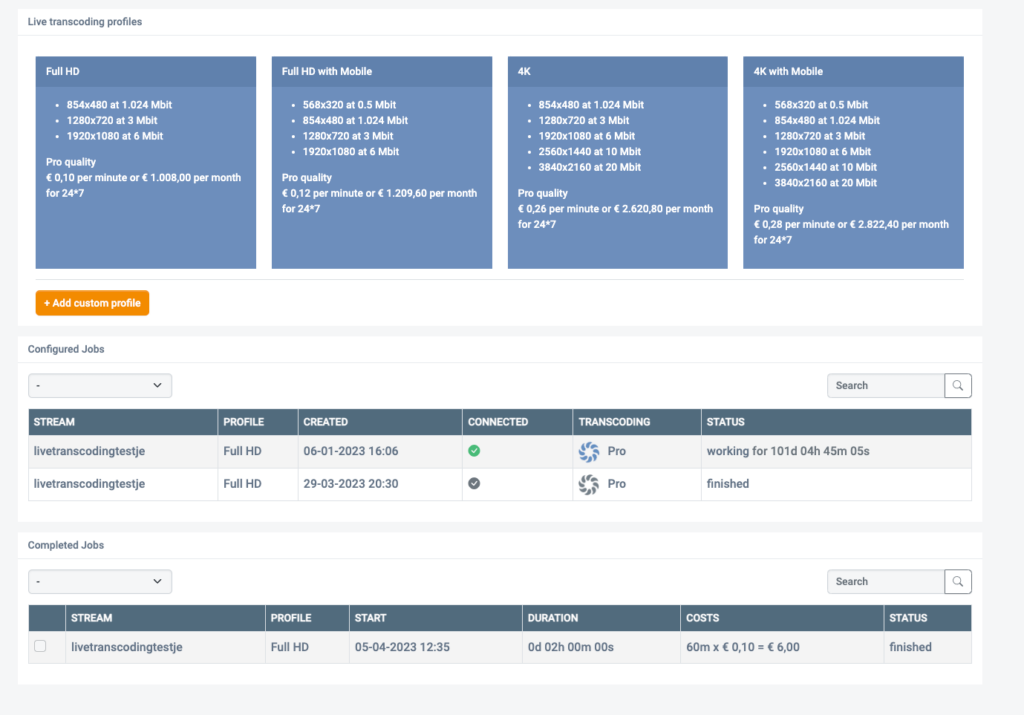
That’s how easy you can professionally transcode your live streams in just 2 steps, either with or without an encoder. Easy huh?
Smart.
Now let’s do live transcoding the smart way. You may want to control per stream in which bit rates it is transcoded, to have complete control over quality and costs, per title, per stream.
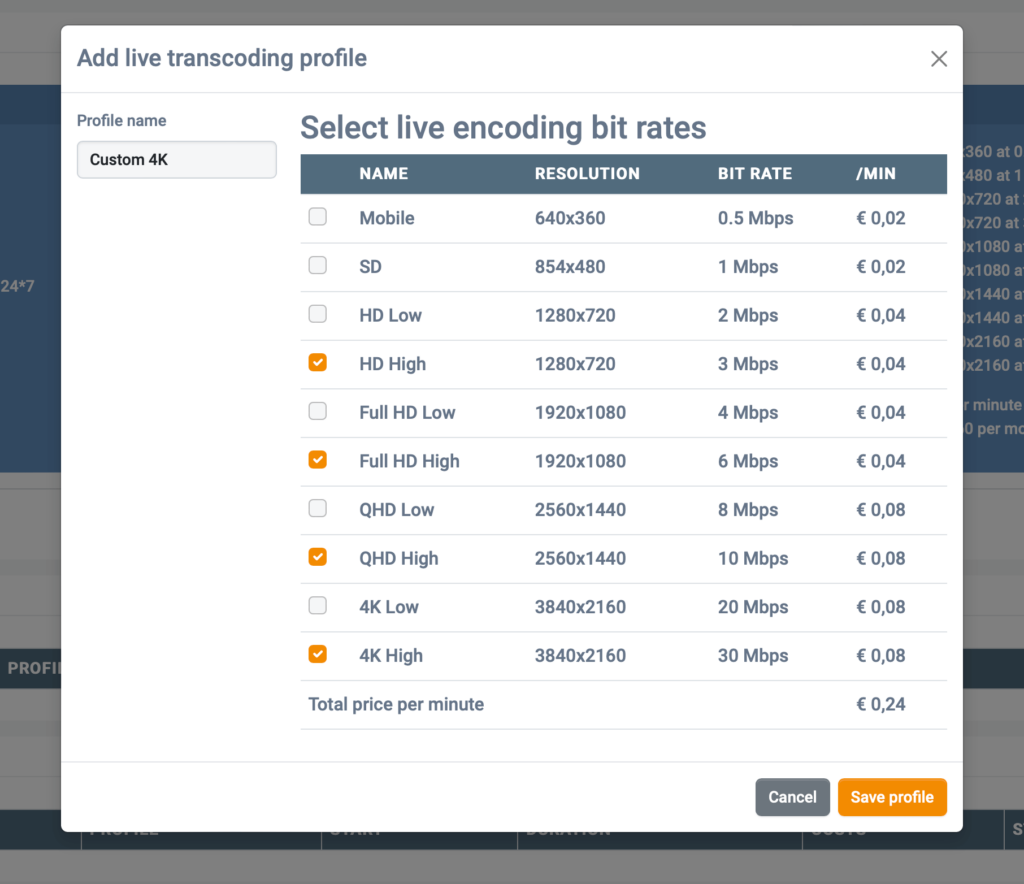
First, go to the Live Transcoding menu and click ‘Add custom profile.’ Select the bitrates you want and click ‘Save profile.’ Instantly, the profile appears in the profile menu. Now go to the Live Stream menu and create a stream. Instead of the default profile, choose the one you created.
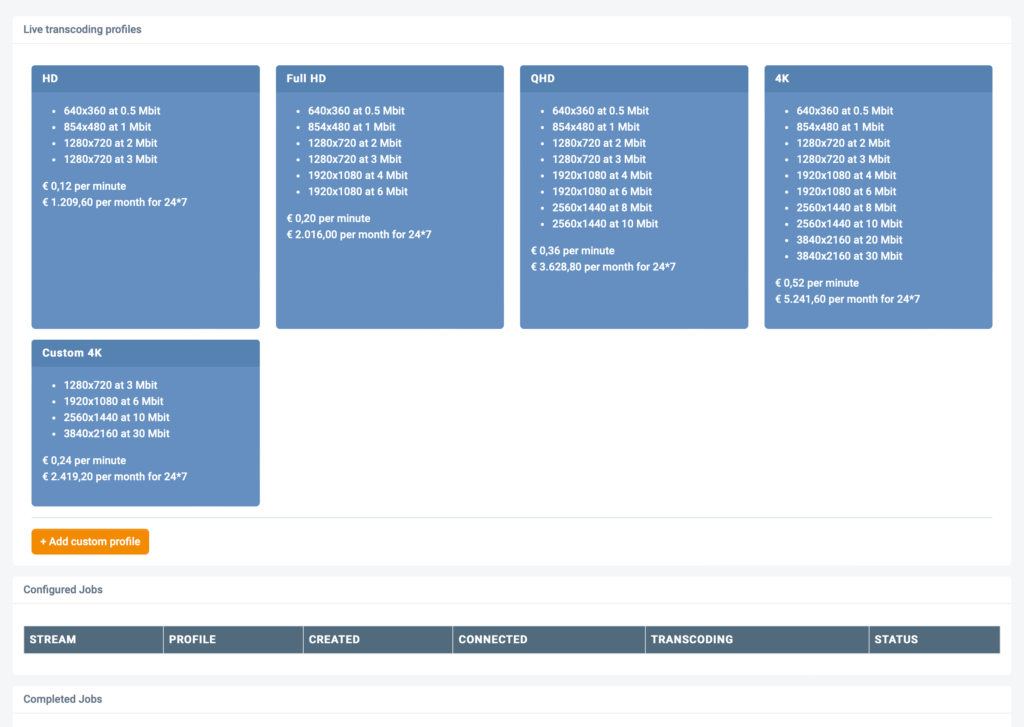
Provide a name for the stream and click ‘Start Live Stream’. Copy the stream key, launch your live encoder, and the stream is transcoded into all the resolutions you selected. Click the play button for player customisation and publishing options.
There are more smart options. Both your original stream and the transcoded adaptive stream are available as individual stream points. So you can preview and compare both streams. You can lock, password protect, geo-fence and multi-CDN distribute both streams separately, and you can publish both if you wish, so you control who gets to see the original stream, or the adaptive bit rate stream.

That’s how you can use our MaelStrom Live transcoding in a smart way. Just create a custom profile and choose it while starting a live stream. Still easy, huh? And it’s so powerful, it gives you full control over qualities and costs. Have you seen anything that powerful and transparent, yet so easy?
Expert.
MaelStrom Live is high quality, cost-efficient and green, it removes a lot of complexity and reduces on-premises hardware and upstream connections, so we don’t really see the reason why you would still want to do your own transcoding.
But, if you still need to do your own live transcoding, that’s of course possible too. For example, if you can do it even cheaper, or better, or need to encrypt streams yourself with your own DRM service. There’s always an edge case. No worries, Jet-Stream has you covered.
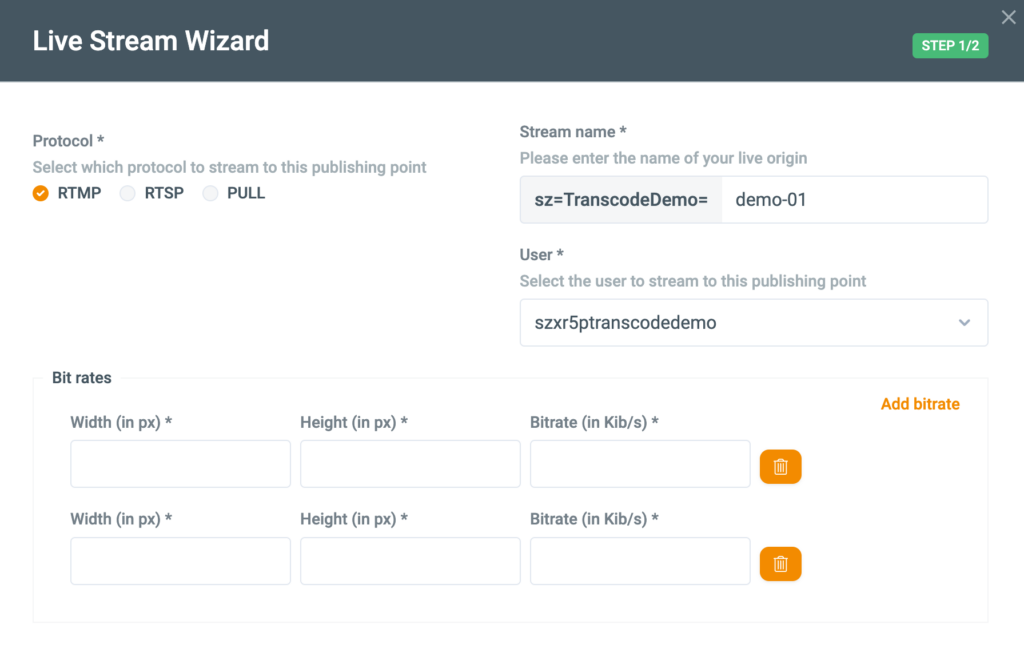
You can send your origin stream in one or multiple qualities to Jet-Stream, through numerous protocols such as RTMP, RTSP and SRT. We take care of transmuxing, and you can upstream your own HLS or DASH streams too. We pull adaptive streams from your encoders, transcoders, and origins, or you can actively push these via webdav to our cloud. And we even support icecast radio streaming, it is quite unique for a streaming platform to support both audio and video services in one unified environment.

The expert method for transcoding involves carrying out the encoding process on your own, and subsequently delivering multi-bitrate stream to our origin servers. We will pass through your original streams in their pristine quality straight to your audience, as adaptive bit rate live streams.
Concluding:
Whether you want to live transcode in the easy, smart, or expert way, we’ve got every use case and workflow covered. With MaelStrom Live, you have full control over your videos and costs! Try it out already today and experience live video streaming in the quality and format that suits you and your audience best.




